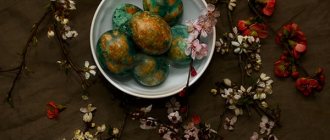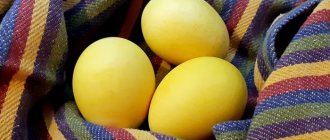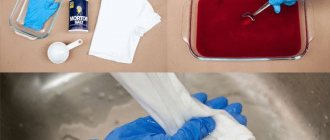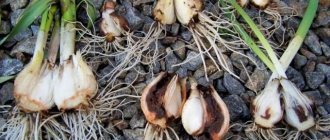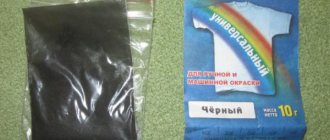During the preparation for Easter , a lot can get out of control, especially when it comes to the arts and crafts aspect of the holiday. All you have to do is go online and hundreds of table decorating ideas for Easter from Pinterest and Instagram can motivate even the laziest to take action.
And now the traditions of the Orthodox and Catholic holiday have already mixed: children are jumping around the apartment with decorative bunny ears on their heads, mom is buying figurines of hens and chicks of all sizes and textures, dad was sent to the store to buy fresh flowers for serving the festive table, and grandma took them out of the closet an old Easter maker and is preparing to make cottage cheese Easter in it! All this is wonderful, just don’t forget that often the simplest and most laconic decor ideas are the most successful. We are talking about coloring eggs with onion skins.
A spectacular and beloved Easter decoration - eggs painted with onion peels.
Natural dye - onion skins - is a long-standing tradition and probably the most popular and affordable way to color Easter eggs. No one since has been able to come up with an easier, more natural and effective method (although coloring with red cabbage !). Now check it out too.
This coloring option is very simple: boil, immerse and dry. It doesn't require much attention or skill. The results are quite, very pretty, especially when you use a combination of brown and white eggs. They are perfect for decorating a homemade holiday table without pathos or excessive overload of details. The most successful serving is when the eggs are placed in a beautiful bowl on fresh grass or even green salad leaves.
Coloring eggs with onion peels involves obtaining shades of red and brown that are amazing in variety and richness, while completely preserving the natural color of the white. Of course, if the shell does not burst and the “paint” does not reach the protein. And don't worry, the eggs won't absorb any of the onion flavor or aroma. These will be simply boiled eggs, colored especially for Easter.
A variety of shades of color of eggs colored with onion skins
Eggs for coloring
It makes no difference what eggs you use - white or brown. Moreover, the lighter the shell, the less intense the coloring will be. The most saturated shades are obtained from eggs with brown shells.
We recommend not coloring raw eggs if you want to get the perfect version. One of the main “enemies” of coloring onion shells is cracked shells. Firstly, the leaked protein will disrupt the harmony of the dye and can suddenly make the eggs unpredictably “marbled”. Secondly, it is not aesthetically pleasing. Thirdly, the cooked protein will “grow” with brown-red cracks. Therefore, it is better to immediately boil the eggs, set them aside with cracked shells, and then paint the whole ones and you will definitely succeed.
Before boiling, remove the eggs from the refrigerator in advance (25-30 minutes). They should warm up to room temperature. This reduces the likelihood that their shell will crack during cooking. Place the eggs in cold water and only then bring it to a boil. Boil the eggs hard (this will take 8-10 minutes after the water starts boiling). Cool them again to room temperature and then paint.
Egg and onion peel for coloring it
Pattern on eggs from leaves, flowers and twigs
The entire painting process will take place exactly as I described above. Only now, before we put the eggs in the finished broth, we must prepare them.
For patterns you will need leaves and twigs, you can take small flowers. Not everyone has flowers blooming outside their window at this time of year, and there are not always herbs available. But ordinary garden greens can be found in any store. Dill, parsley, cilantro, rosemary, tarragon - aromatic herbs with leaves of different shapes and sizes are perfect. You only need a few twigs and leaves. You can pick up a few different ones so that the entire testicle has an individual, unique pattern.
You will also need a thin nylon or mesh to attach the leaves to the egg. It is clear that they themselves will not be able to hold on in conditions of boiling water in a pan. A cut piece of elastic tights works great. And also thread or elastic to tie the nylon tightly to the egg.
Attach the leaf to the egg and wrap it with nylon. Tie the nylon tightly so that it fits tightly around the egg and holds the leaf in place. In this form, place the egg in a decoction of onion peels. Wrap the remaining eggs in the same way, place them in a saucepan and cook for 10-15 minutes in the broth.
After this, cool the eggs and remove the nylon along with the leaves. Their light imprint will remain in the place where they were glued.
It is important to note that white eggs should be dyed this way.
Onion peels for coloring eggs
To accumulate enough onion skins, you have three options: buy a lot of onions, peel them, and immediately use the peeled onions to bake onion tarts and/or make onion soup .
Second option: buy onion skins in a supermarket (self-service) for the price of onions. To do this, from the container in which the onions are displayed, collect the husks into a packaging bag and put two or three onions there for weight.
Third option: go to the market to a trusted vegetable seller, who will happily give you the peels for free. True, to do this, you must first find such a seller for yourself and it is advisable to warn about your visit. For a dozen eggs you will need the peels of 10-12 onions.
Again, you can dye with yellow onion skins, red onions, or even a mix of different colored onion skins, but red onion skins are our favorite! The color of the shell is enchanting.
Collecting onion peels for coloring eggs
Additional ingredients for coloring eggs with onion skins
Salt and vinegar. You will need salt when you boil hard-boiled eggs. By the way, there is an opinion that salt does not help keep the shell intact! Sodium chloride (salt) has no effect on calcium carbonate (shell). The egg is heterogeneous and often contains microcracks that can grow and become “macro.” This is usually due to the large temperature difference between the cold shell and the hot water. We do not give up salt (in any case, it will not harm).
Vinegar is known as an excellent paint fixer. We also use it when coloring eggs with onion peels. Plus it cleans the shell well. Before painting, wipe the shells of boiled eggs with a cotton pad soaked in vinegar. This way the paint will lay down in an even layer.
Uniform coloring of Easter eggs using vinegar
Other natural dyes for eggs
Coloring Easter eggs with natural dyes is a little more complicated than just buying a pack of powder at the store and doing everything in 5 minutes. Also, artificial paint will never give the same noble color, and egg whites will become saturated with harmful substances.
And what a great experiment you can show your children if you paint eggs with various natural dyes! It's so interesting to see how fruits, vegetables and spices give their colors to the Easter egg.
How to dye a dozen eggs with onion skins
Products you need:
- onion peels at least 12 large onions
- 1 liter of water
- 3 tbsp. l. white vinegar
- 12 hard-boiled eggs (white, brown or mix)
- olive or other vegetable oil
From utensils and equipment you need:
- A 3-liter saucepan, preferably made of stainless steel (we don’t recommend using an enameled one - it’s almost impossible to wash it!)
- large sieve
- wooden spoon
- lattice
- paper towel or soft cloth
1. Place onion skins in a saucepan and fill with water. Leave for 30 minutes.
2. Add vinegar to the pan. Stir the contents with a spoon to submerge all the husks in the liquid. Bring the mixture to a boil over high heat.
3. Reduce heat to low and simmer covered for at least 30 minutes.
4. Strain the liquid through a sieve and let cool. This way the color of the shell will be more even. If there is no such goal, you can leave the husk. The liquid should be warm, approximately 70 °C. We don't need to digest the eggs. After all, they should still remain delicious!
5. Place one egg per spoon and gently lower into the liquid. It should completely cover all the eggs. If necessary, add a little water.
6. Leave the eggs in the pan for at least 1 hour. The longer they take to color, the darker they will be.
7. Remove the eggs from the dye with a spoon and transfer to a wire rack.
8. When the eggs have cooled and dried, polish them. To do this, spray a paper towel or cloth with vegetable oil and polish the shell. Store them in the refrigerator, preferably up to 1 week, if you plan to eat them.
Red onion skins for coloring eggs
How to beautifully paint eggs so that they are marbled
The previous dyeing method is ideal for creating eggs with a marbled effect. There is another way, it is a little simpler.
It will require onion peels (any kind), bandages, and some greenery. Chop the husks, but not too finely. There are several ways to wet an egg and roll it in the husk, or place the husk in the middle of the bandage so that it covers the egg when boiling.
Cut the bandage into wide strips so that you can wrap an egg in them.
Next, wrap the egg with this same bandage and secure it with thread so that it does not come undone during cooking.
Now place the prepared eggs in a pan of water and place on the stove. Turn on medium heat, wait until the water starts to boil and reduce the heat slightly. Wait another 5-6 minutes, add 1.5 tbsp. greens and cook for another 13-15 minutes.
Next, turn off the stove, cool the eggs, and remove the bandages. Rinse under clean water and lubricate them with oil.
The result should be beautiful eggs with a marbled effect and a glossy sheen.
Options for additional decoration of Easter eggs
Using the above recipe for coloring eggs with onion peels, you can develop the theme further and use additional decoration. Its essence is to add any objects that leave a mark on the eggshell when painted, that is, we need some kind of stencils for drawing. This can be braid, lace, threads, ribbons and parts of plants: leaves, stems, buds, small flowers and even “boxes” of physalis and strawberry stalks. Plus you will need a nylon/elastic stocking or gauze and ropes/laces, which under no circumstances should be dyed - it is better to use twine.
The stage of coloring eggs in onion peels, decorated with fresh herb leaves
To decorate, you must attach one of the selected objects to the egg, wrap it in cloth and secure it tightly. After you boil an egg wrapped in cloth in onion broth, the pattern will be imprinted on the shell. Stencils can also be attached using rubber bands, threads, or ribbons (without using fabric).
Easter egg decor using leaves and gauze
The result is impressive. For its ideal execution, please note that 1) it is best to use white eggs, 2) wet the shells and only then carefully apply the selected “stencils”, especially when using different parts of plants, 3) it is easier to work with nylon/elastic tights and they do not will leave marks on the painted surface. Gauze will give the additional effect of a small cage, 4) remove the cloth when the eggs have cooled completely.
Eggs painted with onion skins, with additional decoration
The collected husks can also be useful for this more complex decoration. You need to chop it into small pieces. Wet the eggs and roll them partially or completely in the husks, and then wrap them again in cloth.
The stage of decorating eggs for Easter using onion peels and gauze
The decor resembles a small mosaic - very impressive.
The result of using chopped onion peels and gauze to decorate eggs
And finally, if you have skillful hands and artistic abilities, we offer one of the most elegant and original ways to decorate eggs painted with onion peels. These eggs are graceful draperies! For them, you need to scratch the paint with an awl or a thick needle (gypsy needle), after first drawing a sketch of the design on the shell with a pencil. Only use brown eggs, as it is believed that they have a stronger shell. Of course, such almost jewelry work requires skill, but what’s stopping you from practicing in advance!
Eggs colored with onion skins and scratched with a needle
Step-by-step recipe for making marble eggs from husks and green eggs
This method has gained great popularity, because the eggs come out very beautiful and unusual, truly reminiscent of an expensive stone.
You will need:
- eggs
- onion peel
- green eggs - 1-2 bubbles (depending on whether the eggs are white or dark)
- gauze or stockings
- vegetable oil
Detailed description:
- For this method, you will need very little onion peel, since it is needed not for decoction, but for decoration. It needs to be cut into small pieces with scissors. You can grind it in a blender, but remember that you don’t need onion flour, but pieces of different sizes.
- Place the prepared pieces in a flat plate, moisten the eggs with water and roll in the husks.
- Wrap them in gauze or nylon stockings and secure with thread.
- Place in a saucepan, add water, add salt and herbs. Let it cook. It is better to use a stainless pan, as it is easy to clean from the green stuff.
- Free the cooled eggs from gauze and husks. But until they dry, they can get dirty, so it’s better to do this with gloves. Drain on paper towels, let dry and apply shine with vegetable oil.
- This method is more suitable for white specimens, then they turn out brighter, but you can also paint dark ones. The photo shows exactly what came out of the dark eggs.
Easter game that requires colored eggs
Painted eggs are a key element of a fun game that is played not only in the post-Soviet space, but also, for example, in Greece. We don’t have a name for this fun, but the Greeks have it: τσούγκρισμα. It is pronounced TSOO-grees-mah (translated as “to collide”). Two players test the strength of the eggshell and practice their own special, winning strategy. The goal of the game is to break the enemy's egg shell without breaking your own.
To play, each player must hold a colored egg in their hand. The opponent hits it with his egg. When one "end" of the egg is cracked, the egg is turned over and the game continues. The one with the least broken egg wins. It is believed that the winner will have good luck during the year following Easter.
When players break eggs in Greece, one person says “Christos Anesti” (“Christ is risen!”) and another says “Alifos Anesti” (“Truly risen!”).
Easter game
